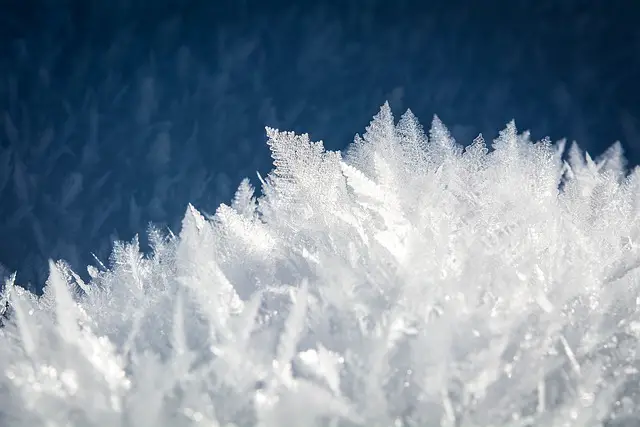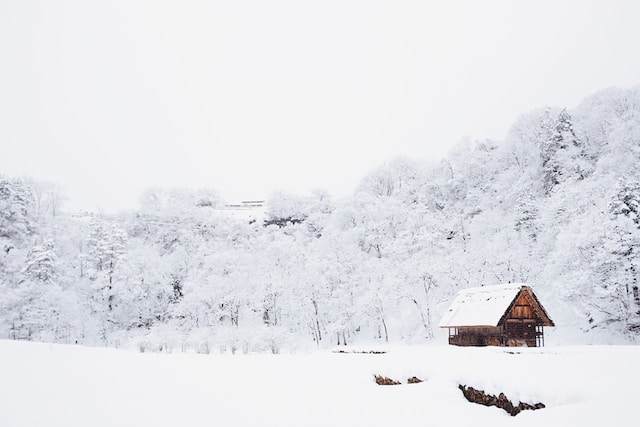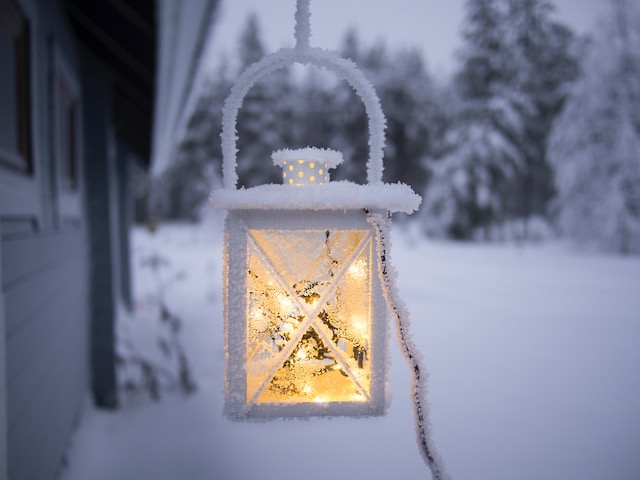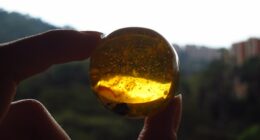Frost is a thin layer of ice crystals that forms on surfaces when the temperature drops below freezing point. Snow, on the other hand, is formed by water vapor in the atmosphere freezing into tiny ice crystals that stick together to form flakes.
What causes frost?
(Image by Petra from Pixabay )

Frost formation requires three things: moisture, clear skies and cold temperatures. When the temperature drops below freezing point (0°C or 32°F), water vapour in the air condenses into tiny droplets on surfaces such as leaves, grass or car windows. However, if the temperature continues to drop further, these water droplets freeze solid.
The process of frost formation is also influenced by wind speed as it can affect how quickly heat is transferred from objects to their surroundings. Therefore areas sheltered from winds are more likely to experience frost than those exposed to high winds.
Interestingly enough, some types of frost only form under specific weather conditions. For example, radiation frost occurs on calm and clear nights when heat radiates away from the ground causing a cooling effect leading to frozen dewdrops appearing like white patches on greenery.
Various factors contribute towards creating different types of frosts making them an interesting topic for meteorologists and nature lovers alike!
What causes snow?
(Photo by Fabian Mardi on Unsplash )

Snow is a common phenomenon that occurs during winter in many regions around the world. But have you ever wondered what causes snow? It all starts with a cloud formation. When moisture-laden air rises and cools down, it reaches its dew point and forms tiny ice crystals.
These ice crystals then combine with other water droplets to form snowflakes. The shape of each snowflake depends on several factors like temperature, humidity, and wind conditions during their formation.
Snowfall occurs when enough snowflakes accumulate in the atmosphere and become heavy enough to fall towards the ground. The amount of snowfall received by an area depends on various factors like altitude, latitude, proximity to large bodies of water or mountains.
Heavy snowfalls can cause severe disruptions in transportation systems and utilities while also posing hazards like avalanches or roof collapses due to excessive weight accumulation.
While we may curse the cold weather that comes with it sometimes, there’s no denying how magical it is watching those delicate flakes falling from above!
Frost Vs. Snow – Key differences
Frost and snow are two different types of frozen precipitation. While they may seem similar, there are some key differences between the two.
One major difference is that frost forms when water vapor in the air comes into contact with a cold surface, such as grass or a car windshield. In contrast, snow forms when water vapor in the air condenses directly into ice crystals.
Another difference is their appearance – frost typically appears as thin, white patches on surfaces while snow falls in larger flakes and accumulates on the ground.
Frost also tends to form during colder temperatures than snow. It can occur at temperatures just above freezing while it usually needs to be below freezing for snow to fall.
The impact of frost and snow can also differ greatly. Frost can damage crops and sensitive plants but generally doesn’t cause significant disruptions to daily life. Snow, on the other hand, can lead to transportation issues and power outages due to heavy accumulation.
How do you measure frost and snow?
Measuring the amount of frost and snowfall is crucial for various industries, including agriculture, transportation, and meteorology. To measure the depth of snow on the ground or surface, one can use a ruler or tape measure. By measuring multiple areas and taking an average, you can get a general idea of how much snow has fallen in that location.
For more accurate measurements of snowfall rates over time, professionals use specialized equipment such as snow gauges. These devices are designed to catch falling snow and measure its weight over time producing data regarding hourly or daily precipitation amounts.
Measuring frost formation is trickier since it doesn’t accumulate in the same way as snow does. Instead, professionals rely on temperature readings from thermometers placed close to surfaces where frost tends to form overnight; these temperatures help determine when frost may occur by forecasting dew point levels based upon humidity levels.
Accurately measuring both frost and snowfall plays a vital role in understanding weather patterns in different regions around the world.
What are the dangers of frost and snow?
Frost and snow might look serene and beautiful, but they can pose serious dangers to humans, animals, plants, and the environment. One of the most immediate dangers is slipping and falling on icy surfaces. Snow or frost can cause sidewalks, roads, stairs, and other surfaces to become slippery and hazardous.
Snowstorms also bring risks of hypothermia and frostbite for people who don’t dress appropriately for cold temperatures. In addition to that, heavy snowfall can damage buildings by collapsing roofs or causing power outages.
Another danger associated with frost is that it can harm crops by freezing them overnight. Frost-damaged crops have a lower yield than healthy ones which results in significant economic losses for farmers.
Finally yet importantly, melting snow can lead to floods when combined with rainwater or rapid temperature changes. Floods are known to cause severe property damage as well as endanger human lives.
It’s important always to take precautions during winter months such as wearing appropriate clothing when going outside in the cold weather conditions while being aware of any hazards near you like ice-covered sidewalks or roadways!
How can you prevent frost and snow damage?
Preventing frost and snow damage can save you a lot of money and headaches in the long run. Here are some tips on how to protect your property from these harsh weather conditions.
One way to prevent frost damage is by insulating water pipes, faucets, and sprinkler systems. By wrapping them with foam insulation or heating tape, you can keep them warm enough to prevent freezing.
To avoid snow build-up on your roof, make sure that your gutters are clean and free of debris. This will allow proper drainage and reduce the risk of ice dams forming which can cause leaks in your home.
You can also prevent snow damage by trimming tree branches around your house that may break under heavy snowfall. This not only protects your property but also prevents injuries caused by falling branches.
When it comes to preventing frost damage in plants, cover delicate ones with blankets or burlap sacks overnight when temperatures drop below freezing point. Applying mulch around plant roots helps maintain soil temperature as well.
Always ensure that cars parked outside have antifreeze solutions added during cold seasons to help engines start easily after being idle for extended periods.
What are the 4 types of frost?
- Hoar Frost – This type of frost forms when water vapor in the air freezes onto surfaces, such as grass or windows, creating white, feathery crystals.
- Advection Frost – Advection frost occurs when a cold wind blows over objects with temperatures below freezing. It creates smooth ice crystals that stick to surfaces like trees and buildings.
- Radiation Frost – Radiation frosts occur on clear nights when heat radiates from the earth’s surface into space, causing it to cool down rapidly. The moisture on vegetation freezes forming needle-like crystals.
- Black Frost- Occurs in areas where temperatures drop dramatically without humidity making plants appear blackened due to frozen sap inside them
Each type of frost has its unique properties and requires specific precautions for prevention or removal methods if necessary. Understanding these differences can help people protect themselves and their property from seasonal damage caused by these weather patterns.
How do you identify frost?
Identifying frost can be a bit tricky, but there are certain signs that indicate the presence of frost. One way to identify frost is by looking at the surfaces around you. If they appear white or have a thin layer of ice on them, it is likely that frost has formed.
Another way to identify frost is by checking the temperature outside. Frost forms when temperatures drop below freezing point, so if you see dew drops turning into ice crystals or frozen puddles in low-lying areas, chances are that there’s been some light frosting overnight.
You can also easily identify frost by simply stepping on it. Frost feels crunchy and brittle underfoot due to its icy texture which differs from snow’s fluffiness and compactness.
Frost can also form on plants causing damage to leaves and flowers; this type of frosting often leads to wilted vegetation with brown spots appearing all over them.
Identifying frost may not always be easy but with these tips in mind, you’ll be able to recognize its telltale signs – especially during winter months when everything looks like it could possibly be frosted!
Featured Image By – Mira Kemppainen on Unsplash








